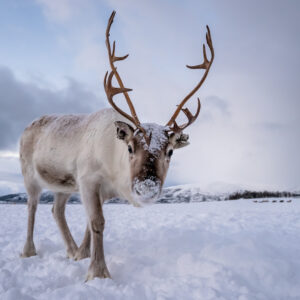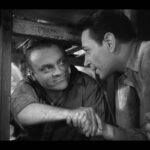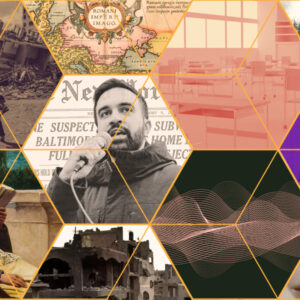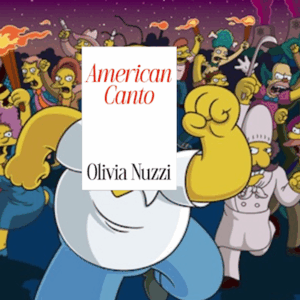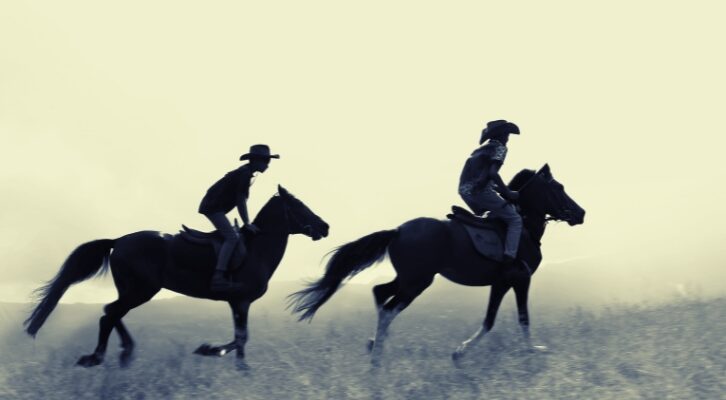
Riding to Freedom: On the Importance of the Horse in Escaping Slavery
“Horses were a part of the daily fabric of life for many enslaved Black people.”
The first time I met the horses and the fugitives, I wanted to speak with them directly. I wanted to know them better, to hear how they planned their escapes, what the moon looked like on the night they left, how they said their farewells. Sometimes they answered, but most of the time they were already riding out of reach.
In the century before slavery was abolished in the United States, advertisements for escaped slaves were regularly printed in newspapers throughout the country. Often, these ads were not only for the people who had run away, but also for the horses they had taken with them.
In the ads, slaveholders offered rewards for their lost property—twenty dollars, seventy dollars, forty-five, sometimes more for the horse than the person. The ads listed physical descriptions of the runaways and the horses; many of them carried the marks of plantation labor on their bodies.
They were jockeys, plowers, wagon drivers, carpenters, printing press operators, shoemakers, barbers, cockfighters, coopers, bricklayers, and painters. They were regular old negroes described as having no particular skills save for shiftiness and connivance.
They had burns and scars on their faces, they had unusually small eyes, they had scars on their wrists and knees, they had bowlegs, they were around five feet ten, they had bushy heads, they were stout, they were slender and stately, they were six feet tall. They stole horses.
Horses were a part of the daily fabric of life for many enslaved Black people.
I don’t want to romanticize the horses. It’s likely that many of the people in the escaped slave notices saw their relationships with horses as mainly one of convenience or necessity. Horses were a mode of transportation, a way of moving quickly across vast distances. But in many ways, it’s the unremarkable nature of this relationship that draws me to these stories.
Horses were a part of the daily fabric of life for many enslaved Black people. The work done by horses, and the enslaved Black people who cared for and maintained the horses, was central to the social and economic landscape of the plantation South.
On the plantation, horses pulled plows and other heavy machinery and cultivated between miles of cash crops. They provided the primary means of transit on and between plantations and neighboring towns, transporting wagons and carrying riders on their backs, sometimes for multiple-day journeys.
Enslaved Black people performed the daily work of grooming, exercising, saddling, and feeding horses. Here, as elsewhere, Black people were responsible for maintaining life—of slaveholders’ families, of agricultural animals like mules, oxen, and horses—even as they were denied the conditions to nurture their own survival.
The escaped slaves who stole horses were exercising the genius of fugitivity: using the mundane to achieve the extraordinary, looking at the resources available and imagining new uses, resistive relations. Stealing horses was an act that shattered the illusion of plantation owners’ control over their land and property. It intervened in the set of circumscribed relationships between Black people, agricultural animals, and white slaveholders that had been established under slavery.
For an escaping slave to steal a horse—property stealing property—posed an economic threat to the plantation. This is why, in the newspaper ads, plantation owners were eager to get their horses back even without the enslaved person who stole them. It’s better to lose one laborer than two.
*
In 1872, Philadelphia abolitionist William Still published The Underground Railroad Records, a massive collection of letters, firsthand accounts, and transcribed stories of the experiences of Black people who escaped slavery. Here, too, were the horses, transporting escaping slaves across rivers, pulling them in carriages, carrying them to the next stop on the railroad.
In 1856, Owen Taylor escaped from Maryland with his wife, child, and two brothers. They were received by the abolitionists of the Philadelphia Vigilance Community. As Still writes, the Taylors had determined that if slave catchers caught up to them, “somebody would have to bite the dust. That they had pledged themselves never to surrender alive, was obvious.” Still was struck by the closeness and care shown among the group, “the joy that the tokens of friendship afforded them.”
“Never to surrender alive.” In making this promise to fight to the death, this acknowledgment of the ways mortality was hastened for so many Black people, the Taylors were also promising to remember the gravity of what it meant to be alive and free. These ancestors whisper through the archives that they were not content to live a half-life, and that even under the unrelenting violence of our world, neither should we.
Still titles the chapter about the Taylors “Owen and Otho’s Flight With Horses, etc.” Setting out from the plantation, the Taylors stole two horses from their master, Mr. Fiery. The horses pulled the Taylor brothers’ wives and children in a carriage, with a speed “that allowed no grass to grow under the horses’ feet.” When they reached Pennsylvania, they “bade their faithful beasts goodbye” and continued on in carriages.
I imagine whispered farewells, a firm pat on a horse’s nose or shoulder before moving on to the next stage of the journey. Or maybe there was no time for all of that, just a glance in the direction of a stable as it receded into the distance.
The Taylors reached freedom in Canada despite Mr. Fiery’s repeated letters attempting to bribe them back into slavery. From Canada, Otho often wrote Still asking for help getting his enslaved family members from Maryland. Still writes that the dangers of such journeys and the abolitionists’ limited funds meant no assistance could be given to Otho. It is here that the story—as much of it as we know from Still’s accounting—comes to an end.
It could be argued that horses were also natural accessories to escape. In addition to speed, they conferred the gift of secrecy. In the Taylors’ story, Still writes, “The horses were easily captured at the hotel, where they were left, but, of course, they were mute as to what had become of their drivers.” Even if stolen horses were found and returned to the plantation owners, they could not communicate where they had been, or what they had seen.
*
In 1822, a slaveholder posted a notice in Newbern, North Carolina, in the Carolina Sentinel, with a reward for the capture of an enslaved person named London Pollock. He described London as a house servant who was “very fond of dress” and who had left wearing a coat with “velvet collar…and striped pantaloons.” London had stolen a horse, who wore “a saddle and bridle with plated mountings.”
Unlike many of the other advertisements, this one doesn’t mention a separate reward for the horse. Instead, it highlights London’s flamboyance and describes him as an “uncommonly intelligent and likely boy.” London’s theft of a horse became part of a larger narrative of being flashy, ostentatious, too smart for his own good.
I’m thinking about the material of fugitivity, its weight and heft. The cloth and leather and striped pantaloons that go into the fashioning of escape.
*
On October 4, 1842, a Black man named Hardy Carroll escaped from the Broke Wake County Jail in Raleigh, North Carolina. Carroll, described in the paper as a “dark complected free negro,” had escaped along with two white prisoners. The white prisoners had been charged with murder, while Carroll had been convicted for horse theft. The sheriff ’s newspaper advertisement notes that the prisoners had probably stolen two horses the night they escaped.
Ten months later, on August 30, 1843, the sheriff once again posted a notice for Carroll, who had escaped the county jail the previous day. In this notice, Carroll is described as having an “exceedingly bad look.”
In the gaps between the 1842 and 1843 notices, we can begin piecing together a story of likely events: Carroll had escaped with the white prisoners, then had been captured and returned. The following summer, he had broken free once again. In these two notices, there is a story of unrelenting commitment to freedom, a politics of obstinacy, and a “bad look”—and several horses stolen.
Reading Carroll’s story through these two notices reminds me that escape isn’t a one-time thing. Often, it is a series of repeated flights—from the prison, from the plantation, from the strictures of citizenship and nation.
I’m thinking about what it takes to run and be captured and decide to run again. I want to believe that Carroll made it across state lines to freedom, that he continued to cow the authorities with his bad look and his hunger for an otherwise. He was in prison for horse-stealing, and yet he may have continued to steal horses on his way out—a stubborn disrespect, a raucous refusal.
*
Throughout the British Caribbean in the seventeenth and eighteenth centuries, it was a common practice for enslaved people to walk behind horses ridden by white riders, often holding the horses’ tails to keep up with their pace.
In an 1810 book titled Authentic History of the English West Indies, the anonymous author writes that, “When a West India gentlemen rides out on horseback, he is usually followed by a negro, who runs after him with surprising swiftness.” Another observer noted that the footmen would regularly run twelve to fourteen miles behind a horse, “a journey of no considerable exertion for the day.”
At the same time, groups of escaped enslaved people in Jamaica established Maroon communities in the mountains of the island. They often raided local plantations, stealing food, tools, and horses. The horses were taught how to navigate the mountainous terrain, how to go where no slave owner could follow. The Maroons were engaged in continuous warfare against plantation owners, and horses were valuable resources to have.
To live like a Maroon, or a fugitive, or a free Black man who escapes prison twice, is to know that theft is a necessary part of liberation.
To live like a Maroon, or a fugitive, or a free Black man who escapes prison twice, is to know that theft is a necessary part of liberation. It is to know that you have been lied to about the ways property shapes your existence, and that you have every right to steal your freedom back.
When I read the stories of the Taylor brothers or Hardy Carroll or the Maroons who built hidden towns in the crevices of the Blue Mountains, the stories of the many named and unnamed ancestors who brought horses with them on their way to freedom, I want to remember the ways they charted alternate geographies of relation; finding co-conspirators where others only saw silent beasts of burden, making kin amid life-rending brutality.
______________________________

Adapted from Mounted: On Horses, Blackness, and Liberation by Bitter Kalli and reprinted with permission from Amistad, an imprint of HarperCollins Publishers. Copyright 2025.
Bitter Kalli
Bitter Kalli is the author of Mounted. They were born and raised in Brooklyn, New York. Their essays and criticism have been published in Harper’s Bazaar, Architectural Digest, and BOMB Magazine, among others. They are a landworker and founder of Star Apple Nursery, a project focused on the stewardship of Caribbean and Southeast Asian heritage crops. Bitter is a child of the Atlantic Ocean. They are based in Philadelphia.









